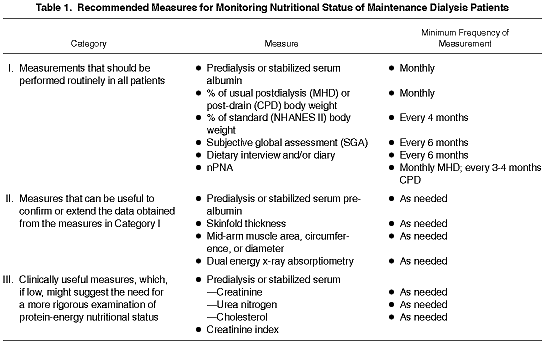
1. Evaluation of Protein-Energy Nutritional Status

The advantages to using these individual nutritional measures are discussed in Guidelines 3 and 8 through 10 and in Appendices III, V, and VII. The combination of these measurements provides an assessment of visceral and somatic protein pools, body weight and hence fat mass, and nutrient intake.
Serum albumin is recommended for routine measurement because there is a large body of literature that defines the normal serum albumin values, characterizes the nutritional and clinical factors affecting serum albumin concentrations, and demonstrates the relationship between serum albumin concentrations and outcome. Body weight, adjusted for height, is proposed because of the clear association between body weight and body fat mass and because body weight is correlated with clinical outcome. SGA is recommended because it gives a comprehensive overview of nutritional intake and body composition, including a rough assessment of both muscle mass and fat mass, and because it is correlated with mortality rates. Assessment of nutrient intake is essential for assessing the probability that a patient will develop PEM, for evaluating the contribution of inadequate nutrient intake to existing PEM, and for developing strategies to improve protein-energy nutritional status. Also, nutrient intake is correlated with clinical outcome. nPNA provides an independent and less time consuming assessment of dietary protein intake (DPI). Dietary interviews and diaries can be used to assess intake not only of protein and energy but also of a variety of other nutrients as well as the pattern and frequency of meals (information that may aid in identifying the cause of inadequate nutrient intake). A low predialysis or stabilized serum urea level may indicate a low intake of protein or amino acids.
*A predialysis serum measurement is obtained from an individual immediately before the initiation of a hemodialysis or intermittent peritoneal dialysis treatment. A stabilized serum measurement is obtained after the patient has stabilized on a given dose of CAPD.